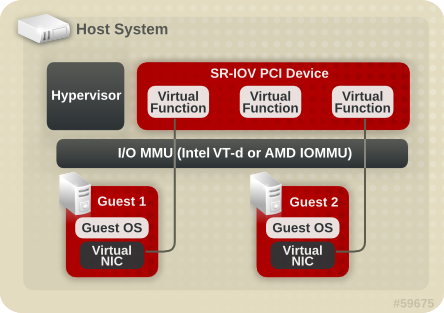The PCI-SIG (PCI Special Interest Group) developed the Single Root I/O Virtualization (SR-IOV) specification. The SR-IOV specification is a standard for a type of PCI passthrough which natively shares a single device to multiple guests. SR-IOV reduces hypervisor involvement by specifying virtualization compatible memory spaces, interrupts and DMA streams. SR-IOV improves device performance for virtualized guests.
SR-IOV enables a Single Root Function (for example, a single Ethernet port), to appear as multiple, separate, physical devices. A physical device with SR-IOV capabilities can be configured to appear in the PCI configuration space as multiple functions, each device has its own configuration space complete with Base Address Registers (BARs).
SR-IOV uses two new PCI functions:
Physical Functions (PFs) are full PCIe devices that include the SR-IOV capabilities. Physical Functions are discovered, managed, and configured as normal PCI devices. Physical Functions configure and manage the SR-IOV functionality by assigning Virtual Functions.
Virtual Functions (VFs) are simple PCIe functions that only process I/O. Each Virtual Function is derived from a Physical Function. The number of Virtual Functions a device may have is limited by the device hardware. A single Ethernet port, the Physical Device, may map to many Virtual Functions that can be shared to virtualized guests.
The hypervisor can map one or more Virtual Functions to a virtualized guest. The Virtual Function's configuration space is mapped to the configuration space presented to the virtualized guest by the hypervisor.
Each Virtual Function can only be mapped to a single guest at a time, as Virtual Functions require real hardware resources. A virtualized guest can have multiple Virtual Functions. A Virtual Function appears as a network card in the same way as a normal network card would appear to an operating system.
The SR-IOV drivers are implemented in the kernel. The core implementation is contained in the PCI subsystem, but there must also be driver support for both the Physical Function (PF) and Virtual Function (VF) devices. With an SR-IOV capable device one can allocate VFs from a PF. The VFs appear as PCI devices which are backed on the physical PCI device by resources (queues, and register sets).
Migrating guests with SR-IOV is possible with the vhost-net feature.
SR-IOV devices can share a single physical port with multiple virtualized guests.
Virtual Functions have near-native performance and provide better performance than para-virtualized drivers and emulated access. Virtual Functions provide data protection between virtualized guests on the same physical server as the data is managed and controlled by the hardware.
These features allow for increased virtualized guest density on hosts within a data center.
SR-IOV is better able to utilize the bandwidth of devices with multiple guests.


